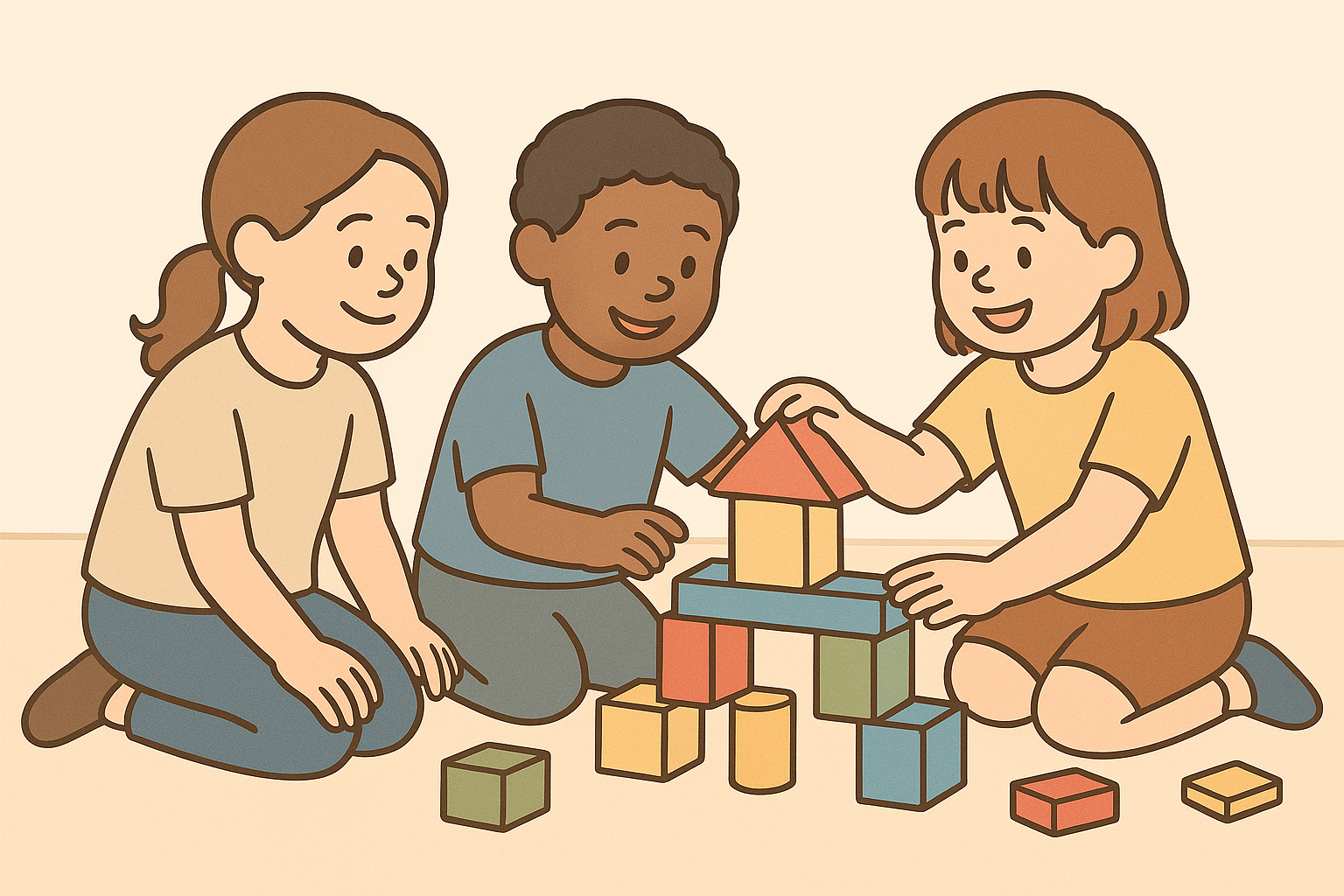How Cooperative Play Teaches Sharing and Teamwork
How Cooperative Play Teaches Sharing and Teamwork
When kids learn to play with each other instead of just next to each other, something amazing happens — they start to understand teamwork, patience, and empathy.
Cooperative play helps children see that collaboration is just as rewarding as independence. It’s not about winning or losing — it’s about connecting, communicating, and solving problems together.
Let’s explore how to foster cooperation through play at home, school, or anywhere little learners gather.
What Is Cooperative Play?
Cooperative play is when children work together toward a shared goal — building a tower, finishing a puzzle, or creating a story together. It’s one of the highest stages of social play, developing around ages 4–6 (but beneficial at any age).
Cooperative play teaches kids to:
Share materials and space.
Listen and take turns.
Respect different ideas.
Solve conflicts peacefully.
💡 Fuzzigram tip: Kids practice real-world social skills best when they’re having fun — not when they’re told to “share.”
See Role Play Games That Build Empathy and Emotional Intelligence.
Step 1: Start with Simple Shared Goals
Begin with easy, low-pressure activities that require teamwork to succeed.
Try:
Building a block tower together.
Rolling a ball back and forth.
Completing a jigsaw puzzle as a pair.
💡 Fuzzigram tip: Keep goals achievable — success builds motivation to cooperate again.
See Independent Play: How to Foster Focus and Confidence in Kids.
Step 2: Use Group Challenges
Turn solo play into team adventures!
Ideas:
“Can we build a bridge strong enough for the toy car?”
“Let’s make a blanket fort big enough for everyone.”
“Can we move the ball across the floor using only spoons?”
💡 Fuzzigram tip: Give each child a clear role (builder, tester, designer) — this reduces conflict and teaches contribution.
Step 3: Celebrate Collaboration, Not Competition
Competition can be motivating, but cooperation builds empathy and communication.
Instead of “Who can finish first?”, try “Can we finish together?”
💡 Fuzzigram tip: Use phrases like “We did it!” instead of “You won!” — language shapes how kids see success.
See Music and Movement Activities That Help Kids Learn Rhythm and Emotion.
Step 4: Try Creative Team Projects
Group art projects naturally build collaboration.
Ideas:
Create a giant mural or cardboard city.
Design puppets for a group show.
Work together on a shared nature collage.
💡 Fuzzigram tip: Each child’s piece adds to the whole — this teaches contribution and belonging.
Step 5: Use Storytelling to Teach Teamwork
Create stories together where each person adds one sentence, sound, or character.
Example:
“Once upon a time, there was a brave penguin…”
“...who found a magic shell…”
“...that could talk!”
💡 Fuzzigram tip: Story-building encourages listening, patience, and creative compromise.
See The Magic of Puppet Play: How Storytelling Builds Imagination.
Step 6: Include Cooperative Outdoor Games
Movement adds excitement and coordination.
Try:
Parachute games (“Make waves together!”).
Follow the Leader.
Pass the Balloon (without using hands).
Group scavenger hunts.
💡 Fuzzigram tip: Emphasize teamwork over winning — physical cooperation builds trust.
Step 7: Model Cooperation Yourself
Children learn by watching you.
Narrate cooperative behavior aloud:
“Let’s work together to clean up!”
“I’ll hold this while you pour.”
💡 Fuzzigram tip: Kids imitate teamwork when they see it modeled calmly and joyfully.
Step 8: Teach Conflict Resolution Through Play
When conflicts arise (and they will!), treat them as learning opportunities.
Guide your child to:
Express feelings (“I felt sad when you took that.”)
Listen to others (“How did that make you feel?”)
Find a solution together (“What can we do next time?”)
💡 Fuzzigram tip: The goal isn’t perfection — it’s progress through practice.
Step 9: Recognize and Praise Cooperation
Point out teamwork in action:
“You waited your turn — that was kind.”
“You both worked together to fix it — great teamwork!”
💡 Fuzzigram tip: Praise effort and communication, not just the result.
Step 10: Make Cooperation Part of Daily Life
Turn daily routines into team moments:
Cooking dinner together.
Folding laundry side-by-side.
Building a pillow fort after bedtime stories.
💡 Fuzzigram tip: Cooperation isn’t just a skill — it’s a mindset. Practiced daily, it becomes second nature.
See Building a Playful Home: Spaces That Inspire Creativity.
Cooperative play teaches more than sharing — it teaches connection. When children build, imagine, and solve together, they learn that their actions affect others — a vital part of emotional intelligence.
Through teamwork, kids develop confidence not just in themselves, but in their ability to belong, contribute, and care.
Because the best kind of play isn’t about winning — it’s about we.
This content is for educational purposes and is not a substitute for professional medical or psychological advice.
Popular Parenting Articles


